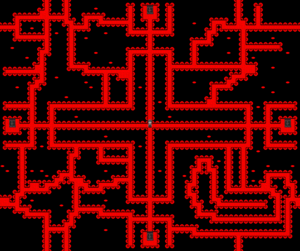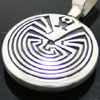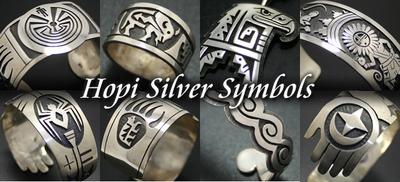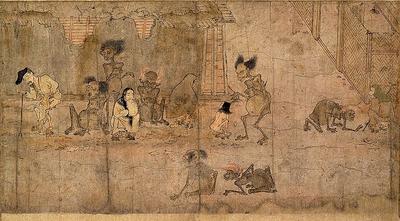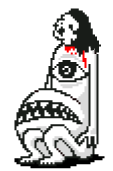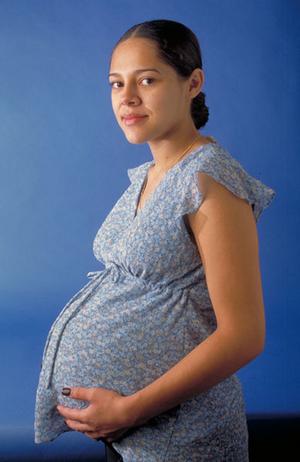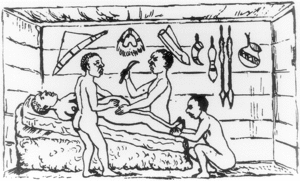Hell(Hopi's motif)
【マン・イン・メイズ(Man in Maze)】
迷路の中心に人間(マン)が立っており、人生を表すモチーフ。人生は色々あり苦しむ事もあるがいつか必ず抜け出せると言う意味。
Humans(A man) are at the center of the maze, which represents the life motif. Meaning to say someday escape life, but sometimes people suffer from some color.
▼ for symbols
http://yumenikki.wikia.com/wiki/Madotsuki%27s_Room(name)#Madotsuki.27s_Room.28Hopi_mythology.29
There is a thing called symbol Indian jewelry, that is what many of them based on the life of Indians. Symbols are often used, for example, motif, is one that almost always seen in Indian jewelry.
Such as jewelry and crafts Indians make shows appreciation for nature, often design the motif of celestial animals and is carried out, the motif is also, and not represent the esoteric language of the Indians of ancient, you are supposed to have derived from the sense of their mysterious religion. As you dig into that sense, there is a difference of interpretation or by tribe, while for others, it might be some differences in the details of the motif. , So that what is written in the following, it is a typical motif with a common interpretation. http://www.rakuten.ne.jp/gold/peace-clothing/hopisymbol.html
Hell(Preta)
俗に、生前に贅沢をした者が餓鬼道に落ちるとされている。ただし仏教の立場から正確にいえば、生前において強欲で嫉妬深く、物惜しく、常に貪りの心や行為をした人が死んで生まれ変わる世界とされる。
It is supposed that those who were extravagant with a lifetime will fall to the Buddhist hell of starvation commonly.
however -- in a lifetime, it is avaricious and envious, if it says correctly from a Buddhistic position -- a thing -- it is regrettable and is considered as Sekai who the person who did the heart and the act which are always coveted dies, and is born again.
しかし大乗仏教では、後々に死後に生まれ変わるだけではなく、今生においてそのような行状をする人の精神境涯をも指して言われるようになった。
However, in Mahayanist Buddhism, the moral circumstances of those who it is not only again born in a postmortem, but make such behavior the future in a now student are also pointed out, and it came to say.
餓鬼は常に飢えと乾きに苦しみ、食物、また飲物でさえも手に取ると火に変わってしまうので、決して満たされることがないとされる。
So would change the fire and pick up even drink brat suffer hunger and thirst always, also, food, it is not to be filled in any way.
極端な飢餓状態の人間と同じように、痩せ細って腹部のみが丸く膨れ上がった姿で描かれることが多い。
Often in the same way as human beings starved extreme, depicted in his abdomen was swollen only round as thin as a dime.
「正法念処経」巻16には、餓鬼の住処は2つある。
Volume 16 "Kay Shobo feeling punished", the abode of the kids there are two.
http://yumenikki.wikia.com/wiki/Number_World(name)#The_Bed_Room.28Naraka_.28Buddhism.29.29
- 人中の餓鬼。この餓鬼はその業因によって行くべき道の故に、これを餓鬼道(界)という。夜に起きて昼に寝るといった、人間と正反対の行動をとる。
- 薜茘多(餓鬼)世界(Preta-loka)の餓鬼。閻浮提の下、500由旬にあり、長さ広さは36000由旬といわれる。しかして人間で最初に死んだとされる閻魔王(えんまおう)は、劫初に冥土の道を開き、その世界を閻魔王界といい、餓鬼の本住所とし、あるいは餓鬼所住の世界の意で、薜茘多世界といい、閻魔をその主とする。余の餓鬼、悪道眷属として、その数は無量で悪業は甚だ多い。
- =====In human brat. Because of the way that you should go by karma, the way that this brat brat (field) this. Preta sleep in the daytime and take action taking place at night, the opposite of human.=====
- Brat (Preta-loka) world (brat) multi 薜茘. Provide under 閻浮, Yujun located 500 feet in length and is said Yujun 36000. Pave the way for a maid to Gosho, said field king Enma that world, King Enma is dead and for the first time in human Shikashite (Let's dance yen), the world of the living plants brat, or to the address book of the brat in the agreement, said 薜茘 many worlds, and its primary Enma. Brat of more than, as Kin malady, and the number is exceedingly often in immeasurable evil.
Hell(Naraka (Buddhism))
Hell Mugen / Abijigoku 2.8 and the corresponding sin Hachinetsujigoku 2
殺生、盗み、邪淫、飲酒、妄語、邪見、犯持戒人、父母・阿羅漢(聖者)殺害。
Killing, stealing, Invisible, drinking, Mogo, Jaken, Jikai human prisoners, killing arhat-parents (saint).
地獄の最下層に位置する。
Located in the lowest layer of hell.
大きさは前の七つより大きく、縦横高さそれぞれ2万由旬。最下層ゆえ、地獄に落ちるまで、まっ逆さまに(自由落下速度で)落ち続けて到着するまで2000年かかる。前の七大地獄並びに別処の一切の諸苦を以て一分として、大阿鼻地獄の苦、1000倍もあるという。剣樹、刀山、湯などの苦しみを絶え間(寸分・刹那)なく受ける。背丈が4由旬、64の目を持ち火を吐く奇怪な鬼がいる。舌を抜き出されて100本の釘を打たれ、毒や火を吐く虫や大蛇に責めさいなまれ、熱鉄の山を上り下りさせられる。これまでの地獄さえ、この無間地獄に比べれば夢のような幸福だという。
Size is larger than the previous seven, respectively 20 000 Yujun height aspect. Therefore the lowest level, to go to hell, take to arrive in 2000 (at a rate of free fall) continue straight fall upside down. As one minute of any of various bitter revamped different treatment, and some large Abijigoku bitter, and a thousand times before the seven major hell. Received (Setsuna-Sunbun) constantly suffering sword trees, mountain sword, and hot water. There are bizarre demon possession tall fire-breathing has four eyes Yujun, 64. The book hit the nail on the tongue 100 is withdrawn, the nagging insects and snake poison and fire-breathing, forced to climb down the mountain of iron heat. Hell even so far, he said, such as happiness dream compared to the hell this Infinity.
小地獄の内容については十六小地獄 (無間地獄) を参照。
The contents of the small hell (see hell Mugen) sixteen small hell.
Hell(Caesarean section)
※Madotsuki was born by cesarean section?
手術方法の完成により、帝王切開そのもので死亡する妊婦はほとんどないが、それでも母体死亡率は経膣分娩の4倍から10倍とされている。 また、術後の長期間安静により肺塞栓症の危険が高まる。そのため、早期離床、早期歩行(術後24時間以内)が原則である。輸液によりhemo-concentration(:循環血中の赤血球濃度の増大)の予防もはかる。
As with all types of abdominal surgeries, a Caesarean section is associated with risks of postoperative adhesions, incisional hernias (which may require surgical correction) and wound infections.[34] If a Caesarean is performed under emergency situations, the risk of the surgery may be increased due to a number of factors. The patient's stomach may not be empty, increasing the anaesthesia risk.[37] Other risks include severe blood loss (which may require a blood transfusion) and postdural-puncture spinal headaches.[34]
A study published in Obstetrics and Gynecology found women who had multiple Caesarean sections were more likely to have problems with later pregnancies, and recommended women who want larger families should not seek Caesarean section as an elective. The risk of placenta accreta, a potentially life-threatening condition, is only 0.13% after two Caesarean sections, but increases to 2.13% after four and then to 6.74% after six or more surgeries. Along with this is a similar rise in the risk of emergency hysterectomies at delivery. The findings were based on outcomes from 30,132 Caesarean deliveries.[38]


